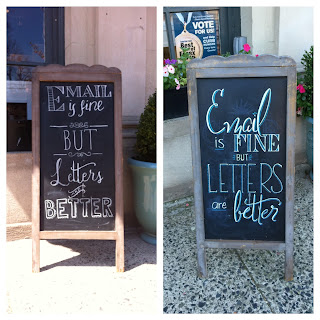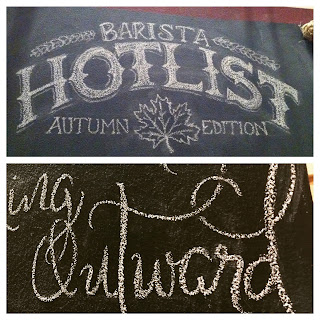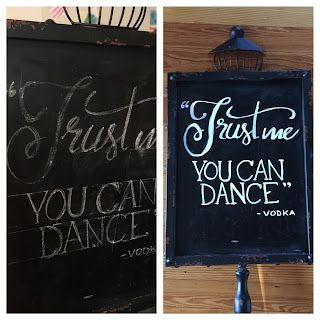 |
| Chalk/Chalk Marker |
As the chalk craft market continues to grow, I'm starting to notice more and more chalkboard and chalk products popping up in stores. One such thing is chalk markers - an opaque wet erase marker intended to be used on dark chalkboards for more permanent or exposed projects. On the whole, I find myself partial to regular old Crayola chalk - it's inexpensive, easy to find, sharpens well, and offers great coverage. However, there is certainly a time and place for each.
The first benefit for chalk, and the major one for me, is the texture created on a high quality chalkboard, such as a traditional slate or chalkboard-painted sheetrock wall.
 |
| THE TEXTURE!! |
Not only are the lines beautiful, but a good board keeps a lot of the buffed out, erased chalk, which I also like the look of. I think that combination of things is the reason people decide to go for the chalkboard look in the first place.
That being said, chalk is sensitive. The obvious benefit of going with chalk marker is that you don't have to be quite so delicate with your finished product once it's all done. So there are instances in which this is a better option. For instance, in the
Acclivity Product Development board that I did a few months ago, I used regular chalk for the lettered heading at the top, but a chalk marker for the calendar skeleton at the bottom. That way, the team could fill in their dates and information, and easily erase it without disturbing the frame.
From a production standpoint, I find that chalk marker is a lot less forgiving. Any imperfections or shakiness in your line are obvious, where as with chalk they are easily fixable or look handmade-in-the-good-way. When I do have to use a chalk marker for a project, I draw my design out in chalk first, then go over the final lines again with chalk marker (read: twice the work).
 |
| Process/Final |
In the above before and after shot, you can see what I mean about sketching out the design, and also observe another benefit of chalk marker: the ink is more opaque and offers better legibility. This is sort of the corollary to the chalk texture thing I wrote about earlier. If a painted board has been used and erased multiple times, the chalk finish can begin to wear off. This creates BAD texture for real chalk, in the form of skipping lines and poor readability.
However, in the first photo I posted at the top of this post, you'll see the same board with the same quote written on it. The board on the left is written in chalk and the board on the right is written with a chalk marker. The chalk marker board is slightly bolder, and also makes use of some color, which also shows up better with a more opaque ink. That said, I still prefer the notsalgic look of more muted, vintage-looking, regular, old chalk.














































